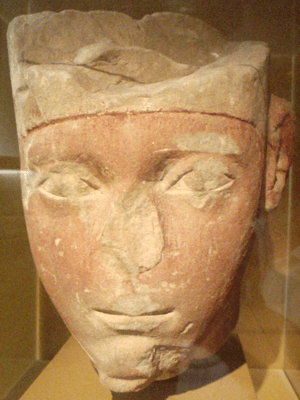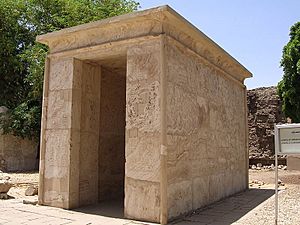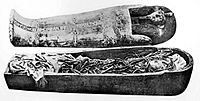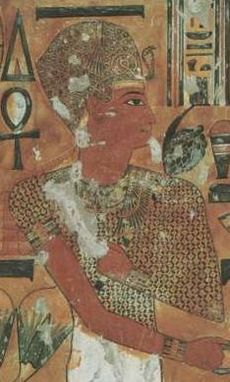Amenhotep I facts for kids
Quick facts for kids Amenhotep I |
|
|---|---|
| Amenophis I | |

One of the few surviving three-dimensional representations of Amenhotep I contemporary to his reign, now in the Museum of Fine Arts, Boston.
|
|
| Pharaoh | |
| Reign | 1525–1504 BC (disputed), 20 years and 7 months in Manetho (18th Dynasty) |
| Predecessor | Ahmose I |
| Successor | Thutmose I |
| Consort | Ahmose-Meritamun, Sitkamose? |
| Children | Amenemhat (died young), possibly Ahmose |
| Father | Ahmose I |
| Mother | Ahmose-Nefertari |
| Died | 1506 or 1504 BC |
| Burial | Mummy found in Deir el-Bahri cache, but was likely originally buried in Dra' Abu el-Naga' or KV39 |
Amenhotep I was an important Pharaoh (king) of ancient Egypt. He was the second ruler of the 18th Dynasty. His name means "Amun is satisfied."
He ruled from about 1526 to 1506 BC. Amenhotep I was the son of Ahmose I and Ahmose-Nefertari. He was not expected to become pharaoh because he had older brothers. However, they passed away, and Amenhotep became the next in line. He then ruled for about 21 years.
During his reign, he kept Egypt strong. He also started a new way of building royal tombs. Instead of having the tomb and temple together, he separated them. This idea was followed by many pharaohs after him. After his death, people honored him as a special god.
Contents
Family Life
Amenhotep I was the son of Ahmose I and Ahmose-Nefertari. His older brothers, Ahmose Sapair and Ahmose-ankh, died before him. This allowed Amenhotep to become pharaoh.
He likely became king when he was still young. His mother, Ahmose-Nefertari, may have ruled for him for a short time. This is because both he and his mother are credited with starting a village for workers. This village was in the Theban Necropolis at Deir el-Medina.
Amenhotep married his older sister, Ahmose-Meritamon. She became his Great Royal Wife. Another wife, Sitkamose, is also mentioned in some old texts.
It is believed he had one son named Amenemhat. Sadly, his son died when he was very young. Since Amenhotep had no living sons, he was followed by Thutmose I. Thutmose I married Amenhotep's "sister," Aahmes. However, some experts are not sure if Aahmes was truly his sister.
How Long Did He Rule?

Historians use different ways to figure out when Amenhotep I ruled. One way is by looking at a special star event. In his ninth year as pharaoh, people saw the star Sothis rise with the sun. This event happened on a specific day.
If this observation was made in Thebes, it would mean Amenhotep I started ruling around 1526 BC. Thebes was the capital city back then, so this date is usually accepted.
An ancient historian named Manetho wrote that Amenhotep I ruled for about 20 or 21 years. This is supported by a text from a magician named Amenemhet. He wrote that he served Amenhotep I for 21 years. So, most historians agree that Amenhotep I ruled for a little over two decades.
Egypt's Foreign Relations

Amenhotep I's royal names suggest he wanted to be a strong ruler. His names mean things like "Bull who conquers the lands" and "He who inspires great terror." These names show his goal to control neighboring areas.
Ancient texts from tombs tell us he led military campaigns into Nubia. Nubia was a region to the south of Egypt. He expanded Egypt's border further south into Nubia. He even built a temple at Saï, which is quite far south. This shows that Egypt had settlements almost to the Third Cataract of the Nile.
There is also a mention of a campaign in a place called Iamu in the land of Kehek. The exact location of Kehek is unknown. Some thought it was in Libya, but that is unlikely. It might have been in Nubia or the western desert. Egypt had lost control of the western desert during an earlier period. It seems Amenhotep I helped Egypt regain control of these areas.
There are no clear records of Amenhotep I leading campaigns in Syria or Palestine. However, his successor, Thutmose I, found no one fighting him when he went to the Euphrates River. This might mean Amenhotep I had already made the area peaceful. But the records from Amenhotep's time are not very clear, so it's hard to be certain.
Culture and New Ideas
Many statues of Amenhotep I exist, but most were made much later. They were part of his special worship after his death. This makes it hard to study the art from his actual reign. However, the few real statues show that artists copied styles from earlier periods of Egyptian history.
It is believed that Amenhotep I started the village for skilled workers at Deir el-Medina. These workers were responsible for creating the amazing art in the tombs of pharaohs and nobles. Amenhotep and his mother were seen as special protectors of this village.
His reign also saw new developments in writing and knowledge. The "Book of What is in the Underworld," an important text about the afterlife, is thought to have been completed around this time. It first appears in the tomb of his successor, Thutmose I. The Ebers papyrus, a main source for ancient Egyptian medicine, also seems to be from this period.
It appears that the first water clock was invented during Amenhotep I's reign. His court astronomer, Amenemheb, claimed to have created this device. Water clocks were very helpful for telling time. They could be adjusted to measure hours accurately, even when the length of the night changed throughout the year.
Building Projects
Amenhotep I started or continued many building projects at temples in Upper Egypt. However, many of his buildings were later taken apart by future pharaohs. We know from old writings that he asked an architect named Ineni to expand the Temple of Karnak. Ineni's tomb text says he built a large gate of limestone at Karnak. He also built a special chapel for the god Amun.
Pieces of these buildings have been found. This has allowed some of his structures to be rebuilt at Karnak. Amenhotep also built structures for his Sed festival. This was a special festival to renew a pharaoh's power after 30 years of rule. But it seems he died before he could use them.
He built a temple in Nubia at Saï. He also built temple structures in Upper Egypt at Elephantine, Kom Ombo, Abydos, and the Temple of Nekhbet. As far as we know, Amenhotep did not build anything major in Lower Egypt, unlike his father.
Royal Burial Place
Amenhotep I was the first pharaoh to separate his mortuary temple from his tomb. He probably did this to protect his tomb from robbers. His mortuary temple was located at the northern end of Deir el-Bahri. This temple was mostly taken down later to make way for Queen Hatshepsut's temple. Only a few bricks with Amenhotep's name remain.
The exact location of Amenhotep's tomb is not known for sure. Two places have been suggested: KV39 in the Valley of the Kings and Tomb ANB at Dra' Abu el-Naga'. Tomb ANB is thought to be more likely. It contains items with his name and the names of some family members.
His Legacy
His Burial
At some point, Amenhotep's original tomb was either robbed or thought to be unsafe. So, his body was moved for protection. It was found in a secret hiding place called the Deir el-Bahri Cache. This cache held the mummies of many New Kingdom kings and nobles.
His mummy was found with its beautiful outer mask (cartonnage) still intact. Because of this, Amenhotep's is the only royal mummy that has not been unwrapped by modern Egyptologists. In April 2021, his mummy was moved to the National Museum of Egyptian Civilization. This was part of a grand event called the Pharaohs' Golden Parade.
Who Ruled Next?
Amenhotep I is believed to have had only one son, who died as a baby. Some sources even say he had no children.
Thutmose I became the next pharaoh. He was a high-ranking military leader. It is not clear if they were related by blood. Some suggest Thutmose I was the son of Amenhotep's older brother, Ahmose Sapair. It's possible Amenhotep named Thutmose I as a co-ruler before he died. However, most experts believe there isn't enough proof for this.
Worship After Death
After his death, Amenhotep was honored as a god. He became the special protector of the village he started at Deir el-Medina. His mother was also honored as a goddess after she passed away.
Many statues of Amenhotep I were made for this special worship. When people prayed to him, he had different names, like "Amenhotep of the Town." He was also known as a god who could give answers or predictions. Some questions asked to him have been found on pieces of pottery. These questions were asked in a way that the statue of the king could "nod" an answer.
Several festivals were held throughout the year to honor him. These festivals celebrated important events in his life, like his death or when he became pharaoh. The seventh month of the Egyptian calendar was even named after one of his festivals.
Old documents describe the rituals for Amenhotep's worship. These rituals involved daily offerings and prayers to his statue. Sometimes, his statue or a priest representing him would even lead the worship of the god Amun. This was a unique practice in ancient Egypt.
Images for kids
-
One of the few surviving three-dimensional representations of Amenhotep I contemporary to his reign, now in the Museum of Fine Arts, Boston.
-
Osiride statue of Amenhotep I, currently housed in the British Museum.
-
Relief of Amenhotep I from Karnak.
-
Stele showing Amenhotep I with his mother, Ahmose-Nefertari
See also
 In Spanish: Amenofis I para niños
In Spanish: Amenofis I para niños











